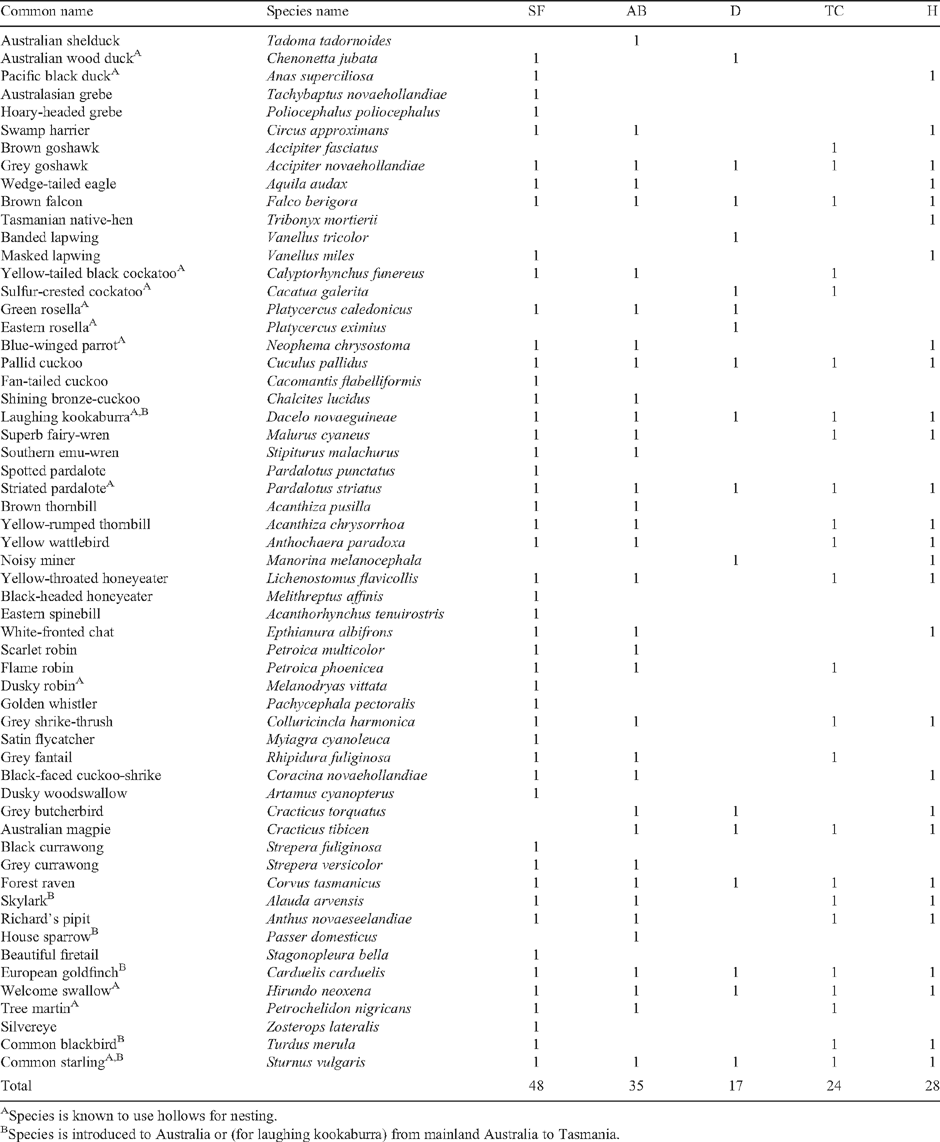Bird use of native trees retained in young eucalypt plantations: species richness and use of hollows
Amelia J. Koch A B C E , Sarah A. Munks A C D and Chris Spencer A CA Tasmanian Forest Practices Authority, 30 Patrick Street, Hobart, Tas. 7000, Australia.
B University of Tasmania, School of Geography and Environmental Studies, Private Bag 78, Hobart, Tas. 7001, Australia.
C CRC for Forestry, Private Bag 12, Hobart, Tas. 7001, Australia.
D University of Tasmania, School of Zoology, Private Bag 5, Hobart, Tas. 7001, Australia.
E Corresponding author. Email: amy.koch@fpa.tas.gov.au
Wildlife Research 36(7) 581-591 https://doi.org/10.1071/WR09037
Submitted: 27 March 2009 Accepted: 7 September 2009 Published: 28 October 2009
Abstract
Context. The retention of mature eucalypts in plantation areas is expected to have biodiversity benefits, especially for animals with specific requirements such as hollow-using species.
Aims. The aim of the current study was to examine the degree to which retained trees embedded in young (≤3 years old) eucalypt plantation provide habitat for birds, whether as a perching/foraging resource for all bird species or as a potential shelter/breeding site for hollow-using species.
Methods. We examined bird use of remnant trees in young eucalypt plantations at five sites in northern Tasmania. Four 20-min surveys were done on 214 trees (101 of these had visible hollows) over two breeding seasons (2007 and 2008). Bird activity at a hollow was recorded during all four surveys, whereas the number of bird species observed in a tree was only recorded during two surveys in the first breeding season. The relationship between both species richness and hollow use with site and tree variables was explored using hierarchical partitioning.
Key results. Bird species richness at a tree was most strongly related to which of the five properties the tree was located on. This may be due to differences in soil fertility and/or the amount of forested area within and around the property. Birds were observed investigating 50 hollows on 36 trees. More than one hollow was used in 10 trees and hollow use was most strongly related to hollow abundance in a tree. High re-use of particular trees (n = 15) and hollows (n = 16) indicates that retained trees vary in the type and quality of habitat they provide for hollow-using birds. The most common hollow users observed were the common starling (Sturnus vulgaris) and the striated pardalote (Pardalotus striatus).
Conclusions and implications. Retaining trees in plantation areas, particularly trees with special features such as hollows, should be encouraged to provide habitat for birds and help contribute to the maintenance of bird diversity in an area.
Additional keywords: biodiversity, retained trees, tree cavities, tree hollows.
Acknowledgements
We thank Great Southern Plantations, Simon Cook in particular, for use of their properties, for the time taken to help select locations and for information provided on the properties. Thanks also to Masa Inada, Denis and Kate Charlesworth and Anne Chuter for their assistance with the bird surveys. Thanks to NRM Cradle to Coast for partially funding this work. Thanks to three anonymous reviewers whose comments greatly improved this manuscript.
Abrahamczyk, S. , Kessler, M. , Putra, D. D. , Waltert, M. , and Tscharntke, T. (2008). The value of differently managed cacao plantations for forest bird conservation in Sulawesi, Indonesia. Bird Conservation International 18, 349–362.
| Crossref | GoogleScholarGoogle Scholar |
Estades, C. F. , and Temple, S. A. (1999). Deciduous-forest bird communities in a fragmented landscape dominated by exotic pine plantations. Ecological Applications 9, 573–585.
| Crossref | GoogleScholarGoogle Scholar |
Gibbons, P. , Lindenmayer, D. B. , Barry, S. C. , and Tanton, M. T. (2000). Hollow formation in eucalypts from temperate forests in southeastern Australia. Pacific Conservation Biology 6, 218–228.
Kavanagh, R. P. , and Turner, R. J. (1994). Birds in eucalypt plantations: the likely role of retained habitat trees. Australian Birds 28, 32–40.
Loyn, R. H. , McNabb, E. G. , Macak, P. , and Noble, P. (2007). Eucalypt plantations as habitat for birds on previously cleared farmland in south-eastern Australia. Biological Conservation 137, 533–548.
| Crossref | GoogleScholarGoogle Scholar |
Recher, H. F. , Majer, J. D. , and Ganesh, S. (1996). Eucalypts, arthropods and birds: on the relation between foliar nutrients and species richness. Forest Ecology and Management 85, 177–195.
| Crossref | GoogleScholarGoogle Scholar |
Whitford, K. R. (2002). Hollows in jarrah (Eucalyptus marginata) and marri (Corymbia calophylla) trees. I. Hollow sizes, tree attributes and ages. Forest Ecology and Management 160, 201–214.
| Crossref | GoogleScholarGoogle Scholar |

Woodley, S. J. , Johnson, G. , Freedman, B. , and Kirk, D. A. (2006). Effects of timber harvesting and plantation development on cavity-nesting birds in New Brunswick. Canadian Field Naturalist 120, 298–306.




